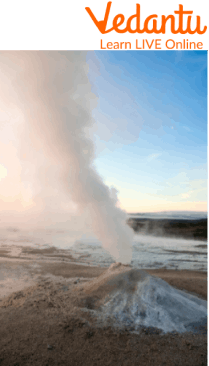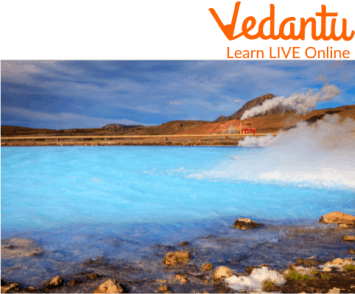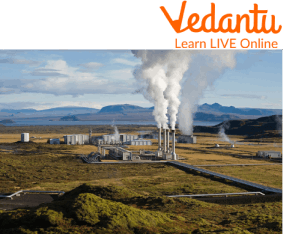




What Is Geothermal Energy? Definition, Advantages & Applications
In some places, geothermal energy has been used for heating and cooking for thousands of years. It is merely energy produced by the heat of the Earth. The rock and liquids beneath the Earth's crust hold this thermal energy. From underground sources to several kilometres below the surface or even deeper still to the molten rock known as magma, it can be found. Geothermal energy is an example of renewable source of energy.
Sounds fascinating, doesn't it? Let's get a closer look into the subject and learn more about Geothermal Energy.
What is Geothermal Energy?
Renewable energy derived from the Earth's core is known as geothermal energy. It originates from heat produced during the planet's initial creation and the radioactivity of elements. In the earth's core, rocks and liquids contain this thermal energy. This is geothermal energy definition. Thermal energy is continuously transferred from the planet's interior to its surface due to the difference in temperature between the earth's core and its surface.
A portion of the rock inside the Earth's core melts at temperatures over 4000°C to generate hot, molten rocks known as magma. Given that the mantle is lighter than the underlying rock, this heat also forces a proportion of it to convect upward and act plastically.
Geothermal energy is an example of potential resources (potential resources exist in a region and can be used in the future). The rock and liquids in the crust of the Earth can get as hot as 370°C. It is possible to find thermal energy in the rocks and liquids as deep as many miles below the Earth's surface.

Geothermal Energy from Earth’s Core
Example of Geothermal Energy
1. Geothermal-Heated Homes
The primary use of geothermal energy is for home heating. A huge network of coils that harvests heat from the earth is connected to the perfect geothermal heat pump. Then, this heat is distributed throughout the house with the assistance of conventional ducts.
2. Geothermal Power Systems
Electricity can be produced from the thermal energy below the ground's surface. Steam from the earth is used by geothermal power systems to produce electricity.
3. Warm Springs
The earth is home to a variety of natural hot springs. When deep water interacts with a heated rock, hot springs are created. Geological heat is released while the water warms up.
4. Greenhouse
A lake is of the utmost importance if it is located next to a greenhouse. The lake is equipped with a network of heating coils, and antifreeze is poured into the water.
5. Fumarole
Water already existing underground heats up as it comes into contact with hot stone or magma and escapes through a vent. Fumarole is the name of this event.
6. Spa
Geothermal energy is used in activities that are related to health and wellness. Natural springs and fumaroles are used in spas as well as other related industries to produce heat and steam. This method of utilising geothermal energy has existed for a very long time.

Spa using Geothermal Energy
How Does Geothermal Energy Work?
Geothermal power is heat that is produced by the planet's interior. It is a substitute energy source suitable for heating, bathing, and cooking. Additionally, it can be changed into electricity. Everywhere on the surface of the Earth, geothermal energy is accessible. Some locations, like Iceland, have heat that is so close to the ground that it may be used as a source of energy with ease. To get to the heat in some locations, holes must be bored through the rocks.
The breakdown of some chemical elements results in the production of heat from within the Earth. Friction caused by the collision of continental plates also generates geothermal energy. The ideal places to use geothermal power are near plate borders or volcanoes. Lava, geysers, fumaroles, and geysers are among the surface features that are frequently found in areas close to volcanic activity. Geothermal energy extraction may be more difficult in other locations.

Steam Rises from the Smokestacks of a Geothermal Power Station
Disadvantages of Geothermal Energy
The disadvantages of geothermal energy are as follows:
Choosing a place where drilling can reach adequate hot rocks is essential. In the UK, there aren't many of these.
In some cases, if too much heat energy is removed, the heat source may "dry up."
There may be minerals and hazardous gases that need to be properly rid of.
Summary
The heat from the earth is known as geothermal energy. The Greek words geo (earth) and thermal are where the word geothermal (heat) originates. Due to the ongoing production of heat deep inside the ground, geothermal energy is a renewable energy source. Geothermal energy is used to produce electricity, heat buildings, and provide hot water to people. This article was about geothermal energy for kids. We discussed geothermal in every aspect in the above article.
FAQs on Geothermal Energy: Meaning, Uses & Examples for Students
1. What is geothermal energy in simple words?
Geothermal energy is natural heat that comes from deep inside the Earth. The word 'geo' means Earth, and 'thermal' means heat. Just like a baked potato is hot on the inside, our planet has a very hot core, and this heat is a powerful source of energy.
2. Is geothermal energy a renewable or non-renewable resource?
Geothermal energy is a renewable resource. This is because the heat at the Earth's core is constantly being produced and is not expected to run out for billions of years. Unlike coal or oil, we can use it without worrying about depleting it.
3. How is geothermal energy used to make electricity?
We use geothermal energy to make electricity in a few simple steps:
- First, very hot water and steam are brought up from deep underground reservoirs through pipes.
- Next, the powerful force of the rising steam is used to spin a machine called a turbine.
- The spinning turbine then powers a generator, which creates electricity for our homes, schools, and cities.
4. What are the main advantages of using geothermal energy?
Geothermal energy has several important advantages:
- It's clean: It produces very little pollution compared to fossil fuels.
- It's reliable: Unlike wind or solar power, it is available 24 hours a day, 7 days a week, because the Earth's core is always hot.
- It's sustainable: It is a renewable resource that won't run out.
- It has a small footprint: Geothermal power plants do not take up much space on land.
5. Are there any disadvantages to geothermal energy?
Yes, there are a few challenges with geothermal energy. The main disadvantage is that it can only be produced in specific parts of the world where the Earth's heat is close to the surface, such as near volcanoes or the edges of tectonic plates. Also, building a geothermal power plant can be very expensive at the start.
6. What are some real-world examples of geothermal energy?
A great real-world example is the country of Iceland, which uses geothermal energy to heat most of its homes and swimming pools. In other parts of the world, it's used to warm greenhouses for growing vegetables, heat water for fish farms, and, most importantly, generate electricity in large power plants.
7. Why is the center of the Earth so hot?
The Earth's center remains incredibly hot for two main reasons. First, there is leftover heat from when our planet was formed billions of years ago. Second, the Earth's core contains radioactive materials that slowly decay, a process that continuously releases a huge amount of heat energy. This constant heat is what powers geothermal energy.
8. Can we build a geothermal power plant anywhere we want?
No, we cannot use geothermal energy everywhere. It is most effective in areas known as 'geothermal hotspots'. These are places where the hot magma from the Earth's mantle is closer to the surface, making it easier to access the steam and hot water needed to generate power. This is why countries on the 'Ring of Fire', like New Zealand and parts of the USA, are leaders in geothermal energy.
9. How is geothermal energy different from solar energy?
The main difference is their source. Geothermal energy comes from heat inside the Earth and is available all the time, day or night. In contrast, solar energy comes from the sun's rays hitting the Earth and is only available during the daytime. While both are clean, renewable energy sources, geothermal is more consistent, whereas solar is more widespread and can be used in more locations.





















